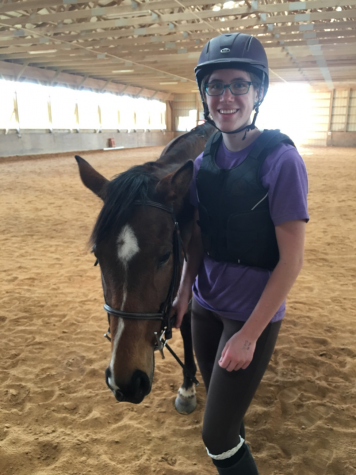The Journey of the Horseback Rider: How Anna Chappell grew to love horseback riding
June 30, 2019

As a child, everyone has that one thing that really draws them in, that fascinates them more than anything.
For Anna Chappell this feeling came in the form of horseback riding.
When Chappell turned seven years old her parents took her to the Kentucky Horse Farm as a birthday present. As she was there her interest in horses was spiked.
At the time that she first started taking interest in horses, Chappell was still dedicated to swimming as much as she could but swimming started to get more competitive she set her sights on horseback riding.
Chappell started off on her horseback journey by taking part in multiple equestrian camps in order to get a feel for it. As time progressed she decided to start lessons. She ended up taking lessons on a small horse farm by the name of Ellen B. Farms in the winter of her seventh grade.
She said on her first lesson she was simply given a horse to ride with not much prior experience in riding because learning as you go makes it easier to understand.
Since she started riding a little over two years ago Chappell has worked with at least 16 different horses of various sizes and temperaments as she moved up in experience.
For each horse she estimated that it took only about 15 minutes to get acquainted and learn stuff like the horses temper, what the estimated gait is, and what the horses favorite side.
Chappell’s current horse is a thoroughbred mare, a thoroughbred is a horse known for its speed, spirits, and agility, that goes by the name Danny.
Chappell said, “Danny has a similar personality to me Danny is a great horse most of the time, but can be really stubborn and annoying especially around other horses. She is particular about jump speed. Not too fast not to slow or she doesn’t jump which can be really annoying.”
Horseback riding requires a vast number of tools and equipment in order to get going. Some types are a saddle; saddle pad; riser pad, a blanket or cloth that is placed under the horses saddle in order to protect the horses back; a girth to keep it in place; and a bridal.
Chappell said that in order to move forward in each step it takes a lot more preparation than you would think. In order to make it up to cantering, the third fastest gait of a horse, it took her up to nine months of prep in order to be allowed to start practicing.
Earlier this year Chappell took place in a riding competition held by the IEA, Interscholastic Equestrian Association, with different areas in the competition ranging anywhere from jumping to cantering. She participated in the events for the walk trot and the walk trot canter.
Competition typically required driving to another farm in order to participate. The farthest one she’s been to was two hours away.
When there her coach would put all of the different horses names into a hat and draw the names for each member. This in turn made it so that all contestants ended up working with a new horse which required them to not only try to perfect each performance but also had to be able to do so while on a horse they were not familiar with.
While in this year at competition Chappell was not able to place very high up in her events, as it was her first year, it motivated her to want work harder. Her goal for her next competition is to get a better understanding of what was going on and also practice more in order to make a higher placing.





